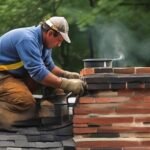Last updated on February 10th, 2024 at 04:31 am
A clean and safe kitchen hood is essential for maintaining a healthy cooking environment in your home. Over time, kitchen hoods can accumulate grease, oil, and other debris, which not only affects their efficiency but also poses a fire hazard.
In this blog, we will discuss effective tips and techniques to keep your kitchen hood clean and safe. By following these guidelines, you can ensure that your kitchen remains free from harmful pollutants and reduces the risk of potential fire accidents.
Understand the Importance of a Clean Kitchen Hood:
A kitchen hood plays a vital role in removing smoke, steam, and odors generated during cooking. It prevents the accumulation of grease and oil on your kitchen walls and cabinets, improving the air quality in your home.
A clean kitchen hood also ensures the proper functioning of the exhaust system and prevents potential fire hazards. Therefore, it is crucial to prioritize regular cleaning and maintenance of your kitchen hood.
Establish a Cleaning Routine:
Create a cleaning schedule to ensure that your kitchen hood receives regular attention. How often you need to clean your hood depends on the frequency of your cooking and the type of food you prepare. Generally, a monthly cleaning routine is recommended, but if you cook frequently or use a lot of greasy ingredients, you may need to clean it more often.
Start with the Filters:

Kitchen hood filters capture grease, smoke particles, and other airborne debris. They are the first line of defense against buildup inside the hood. Begin the cleaning process by removing the filters.
Most filters are dishwasher-safe, so you can either wash them in the dishwasher or soak them in warm, soapy water. Scrub off any stubborn grease or residue with a brush before rinsing and drying them thoroughly.
Clean the Exterior Surfaces:
Grease and grime can accumulate on the exterior surfaces of your kitchen hood, such as the hood canopy, control panel, and fan blades. Use a mild degreased or a mixture of warm water and dish soap to wipe down these surfaces.
Avoid using abrasive cleaners or scouring pads that may damage the finish. Remember to dry the surfaces completely to prevent any water damage.
Degrease and Clean the Hood Interior:
The interior of your kitchen hood is prone to heavy grease buildup, especially around the vent openings. Use a degrease or a specialized hood cleaner to remove the grease effectively.
Apply the cleaner to a cloth or sponge and wipe down the interior surfaces, paying extra attention to the areas with the most buildup. Rinse with clean water and dry thoroughly.
Inspect and Clean the Ventilation System:

Cleaning the visible parts of the kitchen hood is essential, but don’t overlook the ventilation system. Check the ductwork and exhaust fan for any blockages or excessive grease buildup. If necessary, hire a professional to clean the entire ventilation system to ensure proper airflow and prevent potential fire hazards.
Final Thought
Keeping your kitchen hood clean and safe is crucial for maintaining a healthy and hazard-free cooking environment. By establishing a regular cleaning routine, focusing on the filters, exterior surfaces, and interior hood, and inspecting the ventilation system, you can ensure the efficiency of your kitchen hood and minimize the risk of fire accidents.
Prioritizing the cleanliness and maintenance of your kitchen hood not only promotes a healthier cooking environment but also extends the lifespan of your appliance. Invest time in proper cleaning techniques and enjoy the benefits of a clean and safe kitchen hood.




